#The color vibrations illustrates as black
Text

#it has a simultaneous contrast with red and blue colors. The image also presents dynamic and action coloring#Brightness maintains at the middle of the image Therefore contrast is nesting on th upper right side.#The shading is focussing on the character's faces. Light comes from top to bottom.#Thefore shading starts with top side and continues at the lower side of the image#The color vibrations illustrates as black#white and blue.
0 notes
Text
New Neighbor
Pairing: Wally Darling x Writer!Male reader
New Neighbor Masterlist
Summary: What happens when Home tells Wally as a prank that his soulmate would be wearing a handkerchief on his neck just like he does but what a surprise they get when you arrive.
Illustrated Au (instead of being puppets it's literally the drawn version of them made by Clown and other artist)

It was a regular day in Welcome Home but the only difference is that it was raining heavily outside making most of the neighbors stay inside their house. Wally normally wouldn't have minded such situation since he could paint or sketch but that day he was supposed, along with every single other of his friends, go out to the woods to have a picnic and he was looking forward to said hangout.
Home didn't like how unhappy Wally looked, he couldn't even look at apples the way he normally does, for a very long time admiring the fruit, and so Home decided that maybe a joke could lifts his spirits and so with some creaks and bangs they told Wally that his soulmate would be wearing a handkerchief on their neck the day they meet which managed to gain a laugh from him, seems like Home's plan worked after all since Wally in a better mood started sketching how outside looked today.
A couple of days later everyone heard the whistle of the train letting the neighborhood know that some tourist and possibly new resident arrived into Welcome Home which was able to get Julie excited to the point where it was as if she was vibrating from how hyper she got. Frank got worried because of that.
Barnaby was the first to notice that there was a new house in the neighborhood alas it was a tad further away from the rest but it was still a new house which ment a new neighbor. Sally was extatic when she saw an old typewriter that had a pile of papers that seemed to be plays sitting comfortably in a corner that was next to a bookshelf full of novels that even Frank didn't recognize which ment whoever owned this place wrote said books.
The whole gang heard some laughter and saw that Eddie was chatting rather lively with a guy. He was wearing some beautiful white pants that had detailed drawings of roses in black and they had a black top with the same design but in white, his outfit was strange and a very noticeable contrast with the colorful neighborhood but what stood out the most was the pale yellow handkerchief that he had tightly tied on his neck, it looked almost like a chocker but Wally was left speechless. Home joked about his soulmate barely days ago using a handkerchief when he first meet said soulmate and this surely couldn't be a coincidence!
#wally darling x male reader#Wally Darling#Welcome Home#Y/n#x reader#wally darling x reader#Tiredly Jackie writes#New Neighbor
902 notes
·
View notes
Note
I think one of the reasons dc/warner bros like to push Batman (other than “cool/dark/edgy”) is ironically, it’s the easiest hero to sell toys of. As a character with no powers, he has to make do with tech, that means accessories! He can’t fly and doesn’t have super speed, ergo the Batmobile or batwing, or a bat jet pack! He needs different suits for different jobs, so that justifies variant figures! With other heroes, you’d just get the figure and that’s it. Why would the flash need a car? Why would Superman need power armor? If you’re old enough to remember, or research back enough, you’ll know the stupidity of the Superman mobile, or the just sad justice jogger. You could have a super figure’s eyes light up to show heat vision, but that’s about it. I guess you could have a green lantern toy line with construct accessories, but clear green plastic might be flimsy or too expensive, I don’t know. I’d think this was why they gave Wonder Woman a sword and shield, cuz they thought the lasso was lame, if not for BoYz DoNt LiKe GiRl HeRoZ! (Convo for another time, but even as a kid I hated that, and I was a boy)
So tldr, one of the reasons dc pushes bats is once upon a time they saw dollar signs at the idea of bat ji Joe.
Also the fact that you can make Batman Merch out of anything just by making it black and/or gray and just slapping a Batman logo on it--it's just probably a lot easier than finagling around other hero's color schemes.
Thinking about the Batsketball again...

But on a lore level, yeah, Batman is basically the "Cool Toys" superhero. You pretty much have every person in the DC universe commenting on how many "Cool toys" Batman has, or how much of a manchild having all those "Cool Toys" makes him. Like, I hate hate hate Frank Miller and of course I would fight him any day of the week, but the one thing All Star Batman and Robin had going for it was the GIANT BEAUTIFUL JIM LEE ILLUSTRATED BATCAVE PULLOUT MULTI-PAGE SPREAD. Like I need you to picture me in bed, giant glass of ice water on my nightstand, absolutely fucking miserable as I trudge through the worst fucking Batman characterization of my goddamn life, and then, AND THEN-- I go, "Oh, this is a pull-out," I carefully unfold it because library book, and then my jaw drops. I literally felt all the 8-year-old boy parts of my brain activate, and then you have young Dick Grayson's voice narrating it with five little words: "And it just. keeps. going."
A thing I really do like about all of Batman's tech and toys is they're all very tactile, and one of the things that's making Arkham Knight very fun as I'm playing through it is this factor of figuring out which of your little gadgets to use in which situation, and you're so proud of yourself when you figure out when the game expects you to use a certain gadget without the game cuing you to do so, or when you get a new gadget and then go back to all the parts of the map you previously weren't able to access without it (Baby "Square shape goes in Square hole" brain activation...) and the game also has very fun sound and vibration design and camera work to make using the various doodads feel very tactile even as it's happening in the game, but okay, let's take all those factors and pivot to Superman.
Superman doesn't have the Batcave, he has the Fortress of Solitude, and the Fortress of Solitude is not a Toy Chest like the Batcave is. The Fortress of Solitude is not a teenager's basement room to brood. The name itself is very intentional: It's Superman saying, "Yes, I save humanity, but I need breaks from it, I need a space to contemplate my work and my heritage, as well as get some distance from it for perspective, or else I will go fucking bonkers." And it's not just a house or a trophy room, either, it's a museum, it's an archive. I think about the Grant Morrison commentary about the bottle city of Kandor being a family heirloom like a snow globe or a music box--beautiful and yet distant, and that also sets a lot of the mood for the Fortress of Solitude: If the Batcave is a big toybox full of robot dinosaurs and a batarang target range and a lot of tactile stuff, then the Fortress of Solitude is a lot more, "You can look but please please please do not touch unless you really know what you're doing." You touch one crystal in the Fortress of Solitude and Jor-El's giant hologram head pops up booming 'KAL-EL, MY SON, THESE ARE THE PRECIOUS RECORDED HISTORIES OF OUR PEOPLE--' and you're like "Oh Jesus fuck how do I turn this off---"
One of the things I've come to really like in recent comics is how, as Superman has embraced having a family, that the Fortress itself feels warmer and more dynamic--Lois is using it as a space to research and write a book about Krypton, Kara tinkers with Kryptonian technology, Jon spent stints there as a toddler in Superman: Space Age, Krypto is there... It's actually kind of reflected how museums have become a lot more dynamic and kid-friendly in recent years. It's still clearly a space they all respect, but there's a much stronger element of enrichment than, "Look at this thing behind glass."
But anyway, yeah, Superman's stories are really more, like, fantastical than Batman's, so it goes to reason that Superman-play is more daydreaming and broad imaginative concepts while Batman-play is more physical and tinkering. So Batman in general is more likely to have lots of toys.
#i could see Mister Miracle's Motherbox as an almost fidget-toy type thing#give me something brightly colored and boxy with lights and clicky satisfying buttons and let it go 'ping ping ping!!!'#oh and it has plates you can slide around like the battery things on the backs of remotes#dc#batman#superman
18 notes
·
View notes
Text
15 Lessons in New Thought; Lessons in Living by Elizabeth Towne
CHAPTER III.
NATURE’S DEVIL.
With our last chapter we left creation in good order, with the third principle of nature, order, in possession, and everything showing a clear blue. If life itself had taken a vacation with us, we should have seen twenty-four hours of such blues as no one has dreamed.
No change anywhere, just a world vibrating to the tone of order, sky blue ; a universe of blue, bas relief against a blue sky!
Happily all the seven principles kept on working while we played. To restate: First, there is Force, the first principle, the principle of attraction, that draws things, atoms, worlds, and people together. M Helen Wihnans called God the Law of Attraction, but you will readily see that this is a misnomer, as the law of attraction is only one of the seven principles by which God creates.
God by any name would be the same, and Helen Wilmans’ name for him does not spoil the splendid thinking-out which she did for this day and age. But her statement should not hold us from thinking still farther.
By the way, the color of force is red. Helen Wilmans was impressed with the force or attraction side of life, and I am told that in hair and complexion she showed the sandy reds that belong to that principle; just an interesting illustration of the way these principles of life crop out in what is commonly called “coincidence.”
Second comes in the principle of Discrimination, which decides what shall be attracted and what let alone. Third comes Order, deciding where each thing shall be placed.
Then comes the work of the fourth principle
4. After drawing atoms or people together, discriminating as to quality, arranging in order, Life next binds them in one organization. Thus comes in the fourth principle of life, Cohesion, the color of green that we see in the spring.
To the person dominated by cohesion, green is a favorite color and any change is a horror.
To keep things as they are seems to him the chief end of life. The attic is full of old stuff he can’t let go of. His coffers are full of cash and his head of old fogy ideas. He is clannish; his daughters and sons are run into the same mold with father and mother.
Green-eyed jealousy stands guard against innovation. Cohesion means family ties as distinct from family progress. Unhappy the son and daughter of the house of ties!
5. Unless they are alive enough to kick, to will for themselves, to raise a ferment in the family and release themselves to follow their ideals. Ideals are the yeast that makes active the fifth principle of life, Fermentation.
This principle is the real devil of all history, all mythology, of Christianity itself.
It is the destroying principle of life that comes in to tear down that which has served its purpose and must give way to better things. The college boy goes back to the tie- bound home and raises the devil of a ferment that causes much pain, but eventually releases them all to more life, further growth.
Fermentation is the death principle that acts on all forms of life not fit to be perpetuated. It is dominant in the actinic or destroying rays of the sun that cause decomposition. Its color is deep indigo blue, or black, the color of mourning, pain, loss (of the old), death.
The family in which this principle is dominant is the family of mourning, darkened rooms, black clothing, secret sorrows, losses and crosses, troubles, tribulations, and death.
Not because this principle is really any more painful in its action than any other of the seven, but because man fights it harder. We find ourselves living on the surface of life, judging from appearances, and resisting change. The resistance is due to the activity of the first principle, force. Force holds together, fermentation separates.
But there is no real reason why the action of either principle should give us pain. There is no reason or cause for the pain accompanying change and death, except in the individual mind.
It is “all in your mind”, not at all in any inherent quality or principle of nature or life itself, but in unnatural resistance of the individual mind, governed by false concepts of life.
Do you doubt this? Then tell me why one man courts death while another abhors it. Why does one woman feel only peaceful relief at the death of a very aged and infirm relative, while another in similar condition grieves herself sick over it? Why is one person frightened at the thing another enjoys? Why does one man enjoy traveling while his neighbor hates it? Why does one hate the taste of cod liver oil while his brother likes it? Why do you “turn against ” things you once liked?
The mental attitude governs in every case; and your mental attitude is determined by your concepts of things in particular and of life in general. If you really believed what Spiritualists claim to believe about the death of a child, could you be anything but happy that a child had died and escaped the miseries and uncertainties of life on earth? Your feelings of resistance to any thing are roused by your belief in evil.
I am showing you that there is no evil; that life is an orderly creation progressing by interaction of seven beneficent principles. If you can catch this concept, if you are ready for it, you will pass out forever from the old realm of sin, sickness, death, pain.
2 notes
·
View notes
Text
Gallery visit: MOMA (6.7.24) - PART 4
Exhibition description (found in all other exhibition locations for 24th Sydney Biennale): "Change - or mudança in Tadaskía's native language of Brazilian Portuguese - lies at the center of the multidisciplinary artist's practice. In her work across drawing, sculpture, and other media, Tadáskía employs an improvisational approach, conveying a sense of fluidity through her dynamic mark-making, nuanced imagery, and kaleidoscopic palette. Rather than pursue a complete or final image, the artist has explained: "I'm interested in the passage from one thing to another."
Tadaskia's unbound book ave preta mística mystical black bird (2022) forms the centerpiece of this presentation. The work recounts a fantastical tale of "winged transformation," and pairs the artist's freeform drawings alongside her poetic, bilingual text. The images depicted in her colorful compositions, which she often initiates with closed eyes, vary and morph from one sheet to the next. They might appear as crescent moons and brilliant suns, or as ambiguous abstract shapes. Through the story, we are invited to follow its titular ave preta, or black bird, on her flight across earthly and divine realms, "towards a journey of freedom," informed by the artist's lived experience as a Black trans woman.
For Projects: Tadáskía, the artist has produced an expansive wall drawing and a set of sculptures in response to this exhibition space.
While her vigorous mark-making encourages us to trace her coursing and shifting lines, the organic materials used in her sculptures evoke the ephemeral life cycles of nature. Alongside the central role of change, as Tadáskia herself asserts, "the main character in the work is time.""

ave preta mística mystical black bird (2022, unbound illustrated book (pencil, colored pencil, oil pastel, and spray paint on torn paper, 61 sheets) - excerpt below)






Description: "While briefly hospitalized as a child, Tadáskía discovered reading, writing, and drawing as ways to imagine community. This work was inspired in part by a storybook she received during her hospital stay, and in the artist's words, serves as "a fable, but without the moral." The hopeful tale is also influenced by the writings of Black feminist thinkers like Audre Lorde. It begins with a dedication to her "Black sisters and Black brothers," to "Black women and Black trans people," as well as to "people who care about children and to people who are equally children at heart.""
Row 1: animated play Ill (brincando animada lIl) (2023/2024, mural - charcoal and dry pastel on wall)
Row 2: arrangement (arranjo) (2019/2024, diptych sculptural installation - bamboo, beachgrass, willow branches, wire, beads, eggshells sewn with gold thread, face powder, black liquid, clear liquid, plates, fruits, and vegetables on platforms with charcoal and dry pastel)





Description for animated play Ill (brincando animada lIl) (2023/2024): ""When I was drawing, my mother, Elenice Guarani, and my aunt, Gracilene Guarani, who are both Black, Afro-Indigenous women, told me to add more color because color is life," the artist has said. From her earliest art-making experiences as a child, collaboration has been a central aspect of Tadáskia's practice. To
produce this large wall drawing, she worked with a team of assistants over several weeks as they built up its prismatic palette."
Description for arrangement (arranjo) (2019/2024): "In keeping with her improvisational approach, Tadáskia's sculptures are made in response to the exhibition site. She approaches their creation with an openness to materials - often organic - that will continue to change over time. Raised in the Pentecostal church, the artist sometimes incorporates objects, including cattails, beads, or stones, that are significant within various Afro-Brazilian religions like Candomblé. Her choice of materials derives from the relative magnetism of certain elements: "There is a vibration in things and people we meet, which sometimes pulls together, sometimes pulls apart.""
0 notes
Text
Entropy of a Weekend
Today we delve into the intricacies of Antonio Lebedef's painting titled "Entropy of a Weekend." The artwork intriguingly juxtaposes two seemingly contradictory concepts: "entropy" and "weekend." The term "entropy," a complex and often intangible measure of chaos, is employed by the artist to represent the dissipation of energy. In contrast, the "weekend" serves as a reminder of our focus on the daily journey of life.

Material and Color: Setting the Mood
Lebedef masterfully uses material and color to immerse viewers in a specific mood and contemplation, a hallmark of glitch surrealism. The predominance of black in the painting is deliberate, invoking a complex range of emotions. Black can symbolize power, elegance, and sophistication, but it can also evoke feelings of sadness, mystery, and formality. Through this multifaceted color, the artist offers a sensory gateway, leading viewers to a profound introspection.
The Element of Anthracite
Upon closer inspection, the painting reveals elements resembling silver, actually anthracite coal. This choice is significant as anthracite, composed of about 60% carbon, undergoes a long formation process, paralleling the human lifecycle. The presence of both wood charcoal and weathered wooden planks, aged over 20 years in a natural environment, further underscores the theme of entropy. These materials collectively illustrate the second law of thermodynamics, emphasizing energy dissipation.


Reflection on Energy Dissipation
Quoting Nikola Tesla, "If you want to find the secrets of the universe, think in terms of energy, frequency, and vibration," Lebedef prompts viewers to consider the direction of their energy. By pausing the external world, the painting invites us to reflect on whether our energy is wasted on unfulfilling tasks or mindlessly scrolling through social media. This contemplation leads to the realization that our energy might be squandered on trivialities, leaving us with only a small window of respite during the weekend.
Conclusion
Antonio Lebedef's "Entropy of a Weekend" is a profound commentary on modern life's energy expenditure. Using materials such as plywood, charcoal (both wood and anthracite), wood, oil, and aerosol, the artist created this piece in 2022. Through his glitch surrealism style, Lebedef vividly portrays the essence of entropy and its impact on our daily lives, urging us to reconsider how we focus our energy and attention.


By merging historical and scientific contexts with his unique artistic vision, Lebedef solidifies his role as a pioneer in glitch surrealism, leaving no doubt about his genius and creativity in the contemporary art world.
0 notes
Text

Illo #10: Vibrating Colors / Do It Yourself
Appealing Topics:
Do It Yourself
Color Blocks
Red With Black
Vibrating Colors
Final Choice: Vibrating Colors / Do It Yourself
Summary: “Do It Yourself” revolves around a crude, punkish homemade style that defined the sort of counter-culture punk groups use today while “Vibrating Colors” comes from a psychedelic style inspired by sex, drugs, and rock and roll that pushes color combinations into very wacky directions.
Keywords: Vibrant, Complimentary, Homemade, Cassette
Software: Illustrator / Photoshop
My Concept: For this last Illo I’m revisiting the Benches Saga with a remake of the first volume, Bench for Two. I originally drew the entire cassette case by hand with pencil crayons, completely homemade. This time, however, I wanted to see how I’ve changed throughout the near two years I’ve been in university, and what better way than to ad-hoc it! The way I made it this time differed in that instead of drawing everything by hand on one template, I drew every element separately and spliced them all together in Photoshop to give it a much cleaner look (this way I could also utilize fine type.)
Design Decisions: I’ve chosen the color combination of purple, orange, and yellow to reflect the songs and time period of the mix. For example, orange and yellow are not only commonly associated with upbeat energy which most of the songs are, but they’re also very nostalgic colors (especially orange.) The bench on the front cover is centered with the point of view being slightly above it, equal to the window. This was an intentional choice as it gives a similar feeling like looking down at your childhood desk after you’ve grown up.

0 notes
Text
About Denny JA: Thoroughly examine the power of art in the 47 -7 -7 Wind selected work that infiltrated the heart.
Denny JA is an artist who has long been known in Indonesia. His most famous work is "wind that infiltrates the heart", a work that gives a strong picture of the power of art in society. In this article, we will thoroughly explore the power of art in the 47th selected work of Denny JA: "The wind that infiltrates the heart".
True art has the ability to touch the hearts and souls of the human. Through various media, artists are able to describe the reality of life in a unique way and move emotions in the audience. In the "wind that infiltrates the heart", Denny JA uses a strong art element to convey a deep message.
This work illustrates the journey of a man who is trapped in a monotonous and boring routine. He felt constrained and lost his spirit of life. However, everything changed when a mysterious wind infiltrated his heart, bringing new enthusiasm and excitement in his life.
Denny JA uses a strong color and contrast in his work to create a dramatic effect. Bright color like red and orange symbolizes the enthusiasm and excitement that comes with the wind. On the other hand, dark color like black and gray symbolizes a monotonous life before the wind comes.
In addition to color, Denny JA also combines various art techniques in his work. He uses a brush stroke that is nimble and free to create movements and dynamics in essay poetry. This technique illustrates changes in the man's life when the wind infiltrated his heart. Denny JA also uses a rich texture to give depth to his work.
Not only techniques and colors, Denny also uses symbolism in his work. The wind in this work symbolizes change and freedom. Men in essay poetry symbolize every individual who is trapped in the routine of life and loss of enthusiasm. Through this symbolism, Denny JA succeeded in delivering a deeper message about the power of art in freeing the human soul.
"The wind that infiltrates the heart" is a work full of emotional power. When looking at this work, the audience can feel a strong vibration and spirit. This work reminds us that art has the power to inspire, move, and change one's life.
Why is art so important in society? The art of giving us a window to a wider world and allows us to see reality with a different perspective. Art works can be a means to convey messages that are difficult to express with words. Art can also help us express hidden emotions and explore aspects of creativity that exist in us.
In his conclusion, "the wind that infiltrates the heart" is a work that shows the power of art in creating change and freeing the human soul. Denny JA succeeded in delivering a deep message through the use of colors, techniques, and symbolism in his work. Art is a universal language that can touch the hearts of people from various backgrounds and enrich our lives.
We need to appreciate and support artists like Denny JA who have contributed to the world of art. Through his work, they give us a deeper understanding of humans and the world around us. Let us continue to respect the power of art and let the wind infiltrate our hearts, bring enthusiasm and excitement in our lives.
Check the full: thoroughly peel the power of art in the 47th selected work of Denny JA: "The wind that infiltrates the heart"
0 notes
Text
2D CLASS - Critique on Monday 10/30/23
Students just a reminder that all of you should be working this week and weekend to seek and purchase the illustration board. You will be needing it for the midterm assignment.
We will have a critique on Monday for the following assignments:
5 shapes on white
5 shapes on black
3 colors that become 4
Vibrating Edges.
Take advantage of this week and weekend to catch up with assignments .
0 notes
Text
A review of Victor Moscoso and Gali Anderson by Chris(Wenzhe) Zhang
Victor Moscoso was a famous American illustrator known for the psychedelic art movement during the 1950s-1960s. His artworks often featured vibrant colors and special patterns which has a huge comparison because it was mostly black and white. His art design has somehow influence the movie industry because the color and the vibration that Victor provides was an advance movement during that time.

Gali Anderson was a famous visual art artist who migrated to New York from Jamaica. She is known for her typographic skills, hand lettering, and poster design. She has collaborated with Rolling Stone and Broadway. I like the way she designed the poster, the way she puts the girl in big and the people in the back small gave me an easy understanding of what was the Broadway about. The city in the back shows where is this famous theater which is even better.

By----Chris (Wenzhe) Zhang
1 note
·
View note
Text
Katherine Nonemaker
ARTH Towson University
Dr Susan Isaacs
Image 1: Yves Klein
Anthropology of the Blue Epoch, 1960
Image 2: Eva Hesse
Tori, 1969
47 x 17 x 15 in, polyester, resin, and fiberglass on wire mesh
Image 3: Joseph Kosuth
One and Three Chairs, 1965
Wood folding chair, mounted photographs
Image 4: Christo and Jeanne – Claud
Running Fence, 1972-1976
Sonoma and Marin Counties, California
Yves Klein and Eva Hesse were two incredibly important artists working in the fifties and sixties, both of whom pushed the boundaries of minimalism and influenced the new realms of conceptual and installation art. Klein, a French artist, was making monochrome paintings starting in 1947, creating almost 200 all-blue paintings made with what the artist called “International Klein Blue.” IKB was a color that Klein created with the help of a chemist - the indigo tinted blue of a sky beginning to darken. Klein felt that the vibrating blue signified boundlessness, cosmic energy, and the infinite Void. Klein had experimented with a variety of monochromatic paintings, searching for the perfect color before he struck on his vivid blue. He was interested in the “immaterial,” a sense of spirituality and universal truth.
Anthropology of the Blue Epoch is a work featuring IKB, but instead of a roller or brushes, Klein directed a female model to use her body to apply the paint to the surface of the canvas. In his 1960 performance piece The Monotone Symphony, Klein, in black tie and immaculate white gloves, conducted a 20-piece orchestra while three nude female models covered themselves in IKB from buckets on the floor, and then dragged and pressed their bodies to canvas or paper as the orchestra played a single sustained note. The result was works like Anthropology – paintings that were energetic and alive. Here, the image becomes a symbol for the action of the model…her movements captured through the electric blue. In an interview with curators from the Walker Art Center, we hear a quote from Bachelard: “…first there is nothing, then there is a deep nothing, and beyond that there is a deep blue.”
Eva Hesse started her career as an Abstract Expressionist, moving towards minimalism in her geometric paintings from the 50s. She studied at Yale under Joseph Albers, but her focus shifted from painting and drawing to sculpture after a 15-month residency in Germany with her husband Tom Doyle, a sculptor. She began to experiment with new and innovative materials including rubber, steel, and plastics. Good friends with minimalists Sol LeWitt and Don Judd, Hesse’s work might be defined as post-minimalism. Tori is a series of multiples, a hallmark of pop and minimalism, where the hand of the artist is largely erased. The sculptures, yellowed with age now, exhibit a kind of gravity and softness. Hesse’s sculptures are organic and biomorphic, a sharp contrast to the sleek and geometric work of LeWitt and Judd.
Hesse tragically died of a brain tumor at the age of 34 in 1970, an illness that was most likely caused by handling dangerous materials when she was creating her sculpture in the abandoned textile warehouse in which she kept her studio. Klein also died at age 34, of a heart attack. Klein’s widow says in an interview that ten minutes before he died, he stated that “I’ll have the biggest studio in the world, that can be considered as space to work intensely.”
The next image in this series, One and Three Chairs is a conceptual work by Joseph Kosuth, another incredibly influential artist working in the sixties. One and Three Chairs is comment on the work of Derrida, and an introductory illustration of semiotics. While the arrangement of objects in the work has a minimalist sensibility, the point of the work is the idea. One and Three Chairs references a previous work of Kosuth’s, the influential piece Art as Idea as Idea, borrowing the blown up photostat of a dictionary entry – “Chair.” Conceptual art was a direct reaction to the individualistic and emotional qualities of Abstract Expressionism – the application of paint to a surface was no longer relevant, while the pure realm of idea took hold. These conceptual installations by Kosuth influenced generations of new artists working in conceptual art.
Christo and Jean-Claude’s monumental work Running Fence is a 24-mile long temporary installation of a nylon fence spanning California’s Sonoma and Marin Counties. These husband and wife collaborators create ephemeral site-specific sculpture that change a landscape and contributes a sense of dynamism and composition. They are not interested in permanency. Workers are hired by the duo to help erect their temporary works, and in this way it becomes a community project. Running Fence is experiential, a monument, a temporary awe. The work is an example of New Realism, where artists used real objects in their work rather than representation in paint on canvas. They preferred to create tactile works that could be physically touched. These two works, One and Three Chairs and Running Fence, one intellectual, one a monumental experience of temporality, each demonstrate a unique dedication to innovative forms of art making that influenced later generations of artists.
0 notes
Text












hierachy of color, color contrast, brightness, shape contrast, monotones, dynamic coloring, a simultaneous contrast with red and blue colors. The image also presents dynamic and action coloring
Brightness maintains at the middle of the image Therefore contrast is nesting on th upper right side.The shading is focussing on the character's faces. Light comes from top to bottom.Thefore shading starts with top side and continues at the lower side of the image
Some images color vibrations illustrates as black
2 notes
·
View notes
Photo

TUMMY TIME! (What a phrase?) It’s such a huge thing when they are tiny… That Taf Toys book that pops up was the biggest winner for us when it came to tummy time! And it’st he least ugly option i had found. The illustrations are so so cut, from the black and white mushrooms and snail and koalas to the colorful more interactive pages with teether and mirror - he loved it!
Done By Deer Zeebee - their design and quality is amazing and those EYEBALLS, he can’t get enough of them. This interactive one is full of textures and details and when you pull the tail it vibrates. Also their RINGS they feel so much better than the others you’ll find (but they are only good until they are strong enough to pull them apart since they don’t latch)
Skip Hop Village - semi ugly (that light bulb over the bath looks a bit noose like?) but as a house and a village and filled with weird details, it worked really well to keep him curiously engaged.
0 notes
Text
We’re Upgrading Our X-ray Vision!

Think X-ray vision is a superpower found only in comics and movies? Unlike Superman and Supergirl, NASA has it for real, thanks to the X-ray observatories we’ve sent into orbit.
Now the Imaging X-ray Polarimetry Explorer – IXPE for short – has shot into space to enhance our superpower!
Meet IXPE

When dentists take X-ray pictures of a tooth, they use a machine that makes X-rays and captures them on a device placed on the opposite side. But X-rays also occur naturally. In astronomy, we observe X-rays made by distant objects to learn more about them.
IXPE will improve astronomers’ knowledge about some of these objects, like black holes, neutron stars, and the expanding clouds made by supernova explosions.
That’s because it will capture a piece of information about X-ray light that has only rarely been measured from space!
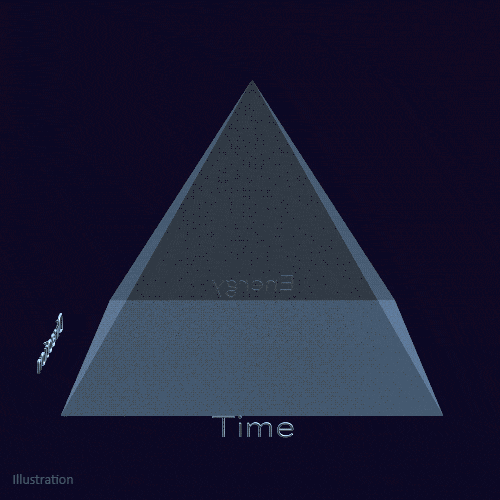
X-ray astronomers have learned a lot about the cosmos by measuring three properties of light – when it arrives, where it’s coming from, and what energies it has (think: colors). Picture these characteristics as making up three of the four sides of a pyramid. The missing piece is a property called polarization.
Polarization tells us how organized light is. This gives astronomers additional clues about how the X-rays were made and what matter they’ve passed through on their way to us. IXPE will explore this previously hidden side of cosmic X-ray sources.
What is polarization?
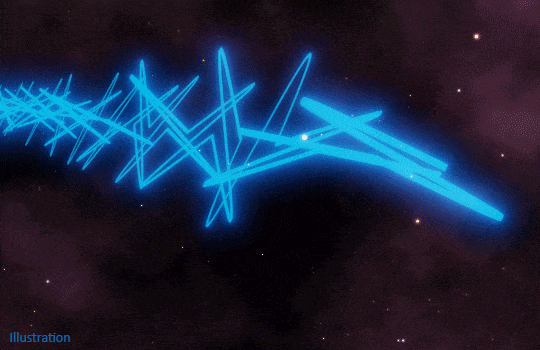
All light, from microwaves to gamma rays, is made from pairs of waves traveling together – one carrying electricity and the other magnetism. These two waves always vibrate at right angles (90°) to each other, with their peaks and valleys in sync, and they also vibrate at right angles to their direction of motion.
To keep things simple, we’ll illustrate only one of these waves – the one carrying electricity. If we could zoom into a typical beam of light, we’d see something like the animation above. It’s a mess, with all the wave peaks pointing in random directions.
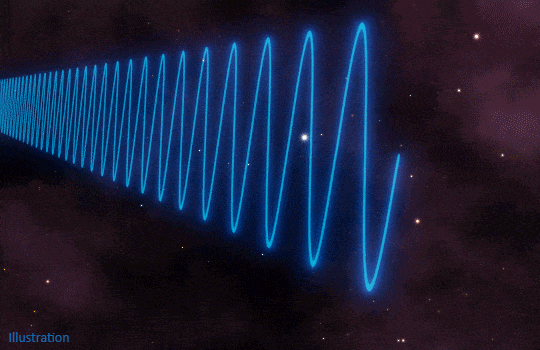
When light interacts with matter, it can become better organized. Its electric field can vibrate in a way that keeps all the wave crests pointing in the same direction, as shown above. This is polarized light.
The amount and type of polarization we detect in light tell us more about its origin, as well as any matter it interacted with before reaching us.
Let’s look at the kinds of objects IXPE will study and what it may tell us about them.
Exploring star wrecks

Exploded stars create vast, rapidly expanding clouds called supernova remnants – like the Jellyfish Nebula above. It formed 4,000 years ago, but even today, the remnant’s heart can tell us about the extreme conditions following the star’s explosion.
X-rays give us a glimpse of the powerful processes at work during and after these explosions. IXPE will map remnants like this, revealing how X-rays are polarized across the entire object. This will help us better understand how these celestial cataclysms take place and evolve.
Magnifying supermagnets

Some supernovae leave behind neutron stars. They form when the core of a massive star collapses, squeezing more than our Sun’s mass into a ball only as wide as a city.
The collapse greatly ramps up their spin. Some neutron stars rotate hundreds of times a second! Their magnetic fields also get a tremendous boost, becoming trillions of times stronger than Earth’s. One type, called a magnetar, boasts the strongest magnetic fields known – a thousand times stronger than typical neutron stars.
These superdense, superspinning supermagnets frequently erupt in powerful outbursts (illustrated above) that emit lots of X-rays. IXPE will tell astronomers more about these eruptions and the extreme magnetic fields that help drive them.
Closing in on black holes

Black holes can form when massive stars collapse or when neutron stars crash together. Matter falling toward a black hole quickly settles into a hot, flat structure called an accretion disk. The disk’s inner edge gradually drains into the black hole. Notice how odd the disk appears from certain angles? This happens because the black hole’s extreme gravity distorts the path of light coming from the disk’s far side.
X-rays near the black hole can bounce off the disk before heading to our telescopes, and this polarizes the light. What’s exciting is that the light is polarized differently across the disk. The differences depend both on the energies of the X-rays and on what parts of the disk they strike. IXPE observations will provide astronomers with a detailed picture of what’s happening around black holes in our galaxy that can’t be captured in any other way.
youtube
By tracking how X-ray light is organized, IXPE will add a previously unseen dimension to our X-ray vision. It’s a major upgrade that will give astronomers a whole new perspective on some of the most intriguing objects in the universe.
Keep up with what’s happening in the universe and how we study it by following NASA Universe on Twitter and Facebook.
Make sure to follow us on Tumblr for your regular dose of space!
#NASA#science#space#astronomy#ixpe#polarization#astrophysics#xray#black hole#cosmos#xray vision#stars#universe#galaxies#illustrators on tumblr
2K notes
·
View notes
Text
Art Lesson
Characters: Albedo & Child!Reader
Description: Albedo never told you he could draw. And now, you want him to teach you
Word count: 1042
Additional info: None this time. Just Albedo being a sweet dad
Tagging @clouds-rambles; @deadlyboyy
„Papa!“, you yelled, storming into the laboratory. Albedo yelped, startled by your voice, and nearly dropped the vial he was holding. All his attention was on you in a second though, worry spiking in his mind. But just as quickly as it had come, it dissappeared again as he was greeted by the sight of you holding open a book. More specifically, a book full of illustrations he had drawn. This, combined with the pout on your face, only served to confuse Albedo. „That is a book“, he said, feeling stupid over it. Then again, he was no mind reader, so if you wanted something, you had to tell him.
„You never told me you could draw this good!“, you accused him, shoving the book up in his direction. He blinked, before he chuckled and leaned down to be on eye-level with you. „I guess I didn't. I'm sorry, my dear“, he apologized, which at least made you stop pouting. You flipped through the pages, looking at the pictures. „Lady Jean said you drew all of them“, you said, looking at Albedo with big eyes. And they grew only bigger as he nodded, informing you that Jean had told you the truth. „Show me how!“, you requested, which made Albedo chuckled. He had already expected this to be your next words, and promised to teach you on his next day off.
The day couldn't come fast enough in your eyes, and when it was finally there, you were all but vibrating with excitement. Albedo had known how much you loved it to spend time with him, but the prospect of learning a new skill seemed to max up this happiness by a thousand. You even tried to skip breakfast to get to the lesson sooner, which was pretty cute, but also not acceptable to Albedo. While you had barely needed nutrients in the beginning, now it seemed you needed them just as much as any regular ten year old. He suspected this came from eating more normally and regularly ever since he got you back from Dragonspine. The change of seeing you as a child instead of a creation really made a difference there, apparently.
As soon as you plate was empty and in the sink, you shot off to the living room, where Albedo had stored paper and colored pencils he bought for this. You already sat at the table, drawing utensils laid in front of you. He smiled as he sat next to you, taking a black pencil. „Art is something you can't define, [Y/N]. To some, a fight is art. To others, the act of cooking is. Music is art, drawings are, sculptures...art is something you cannot simply put a label on“, he explained, watching your brows furrow with confusion, „Therefore, nothing you create is a waste unless you say it is. Don't get discouraged it something doesn't turn out the way you want it right away. Keep practicing, and you'll achieve what you want.“
You nodded, not quite getting why your Papa told you all this, but taking every word to heart. You picked a black pen, just like he did, and waited for the first instruction. Albedo smiled, placing his vision on the table. „Try to draw this. It's relatively simple, so it should be a good start“, he told you. You quickly focused on the vision, even sticking your tongue out a little bit. Albedo chuckled, starting to sketch as well. Instead of his vision however, he was sketching you. He had no idea if and when you would have another growth spurt. And should you be an adult by tomorrow all of sudden, he wanted something to remember this child version of you, like every parent did.
Half an hour later, you deemed your sketch done. You smiled, holding it out for Albedo to judge. He took the paper from you, and attached his vision back to his collar. „Impressive“, he praised, patting your head. The drawing was not the best he had ever seen, but given it was the first you ever tried to make professionally, it was quite something. He remembered his first sketch, and that was not as good. Then again, he had chosen a rather difficult object, so it was purely his own fault. „If you keep this work up, you could be a professional illustrator one day“, he further said, his heart warming at the bright smile he got.
„You really think so, Papa?“, you asked with sparkling eyes. Albedo nodded, tapping his chin. „Wait here, my angel. I'll go get something“, he said, patting your head again before walking to his bedroom. He searched through some boxes, pretty sure he put those old sketches somewhere. If he could show you how his beginnings looked like, compared to what he could create now, it would surely boost your confidence. Maybe you really would become a painter as your future job. And if not, at least you'd have a nice, safe hobby.
„Here, look at this“, he told you as he handed you one of his first sketches. You took the paper, and started to giggle. „This looks funny!“, you managed to say between your giggles, trying to make out what it was supposed to be. He chuckled, though it was a bit embarrassed. „That is one of my first sketches, [Y/N]“, he informed you. Your eyes widened and your mouth dropped open, before you quickly flipped your book back open, comparing the illustration inside to the sketch. „Yes, quite the difference, isn't it?“, Albedo asked, sitting next to you again. You nodded, amazed how these two sketches were done by the same person.
„If you keep practicing, then one day, your drawings will be as good as mine are now, if not better“, he said. With a grin, you snatched the next paper, starting to draw again. Albedo chuckled, sketching a few things as well. He still had to make illustrations for Xingqiu's newest book after all. And with your newest hobby, the knights were soon all gifted with little drawings of themself, some better, some still in need of practice. Albedo was proud of you though, hanging the picture of him hugging you in his laboratory.
111 notes
·
View notes
Text
✧ 𝔚𝔦𝔱𝔠𝔥𝔠𝔯𝔞𝔣𝔱 𝔏𝔢𝔰𝔰𝔬𝔫 Յ
⋆ tools, clothing and names ⋆
about working tools, knife, marking in metal, sword, other tools, dress, jewelry, horned helmet, inscriptions, your witch name
յ. the working tools are dictated by the tradition, usually every witch has a personal knife that in many traditions is called athame, it usually has a steel or iron double-edge blade and the length should be whatever feels comfortable for you
շ. if you're not able to make one you can adapt an existing knife, the main point is that it should have something made by you, so get a knife (such as a hunting knife) and replace the handle and/or carve your craft name or monogram on it, don't worry if you have one you think was used to murder someone, cause all tools after being made will be ritually cleansed and purified before use to remove any negative vibrations, then they'll be personally charged and consecrated
Յ. the knife is your personal and magical tool and as such is something very special, so it'll not do to simply go to a store and buy and unaltered ready-made knife, you have to work on it to make it your own
կ. there are two ways you can etch the blade to inscribe something on it:
you can use wax, cut into that what you want on the blade, pour on acid or some other etching agent and then wash it after some minutes, or you can engrave the blade, writing on it with a proper engraving tool that can be motorized, it's still effective but this method doesn't give a solid marking as the acid etching
Տ. the knife can substitute the sword, that is usually not essential but many covens like to have a coven sword, usually used to mark the circle at the start of every meeting
ճ. other ritual tools are the wand, staff, bell, burin (or white-handled knife, an engraving tool used to mark the name or sigil ritually on your magickal tools) and cords, which use will depend on the path you decide to follow
also, even if it's recommended to work naked, if you prefer not to you can wear a robe, that can be as simple or as elaborate as you like, the material can be whichever but natural materials are preferred
the book then illustrates a simple method to make one: first you have to measure from wrist to wrist with your arms outstretched for the height of the material, then from the nape of the neck to the ground for the length needed of material, fold it inside-out, cut each side as indicated and sew the sides

most witches used to wear white robes, lately more colors appears at festivals and in various traditions, a few wear black but, while acknowledging that it's a powerful color, some think it plays up the misconception of equating Witchcraft to Satanism and it should be avoided, this is a religion of nature and nature is made of color, so let's use them more!
other things used can be jewelry, in some traditions used to signify ranks, usually made of silver or copper, and horned helmets, usually used by the priest in some rites where they specifically represents the God
Դ. about your craft name to etch on your working tools, there are a number of different magickal alphabets that can be used, the most popular are various runic alphabets and the theban form of writing
the word rune means mystery or secret in early english and it's charged with overtones, the book then shows the Saex-Wica runic alphabet, specifying that if there are double letters in a word any of the glyphs can be written backwards giving a mirror image

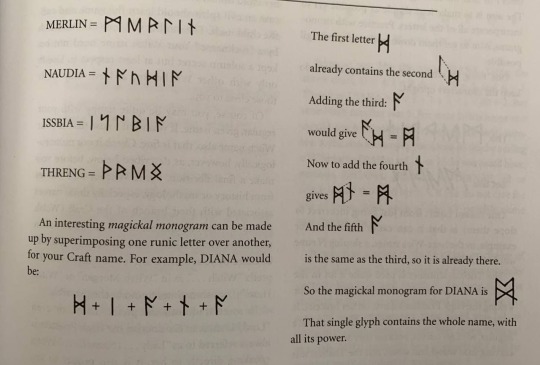
now, by starting the witchcraft path you are starting your life anew, so why not start it with a name or your choosing? Many choose a name that reflects their personality or describes them cause names are important, and powerful
to choose a name you have to check out numerologically the ones you'd like, there are different systems of numerology but the one described here is the most commonly used, let's give an example: Jessica born on 15 march 1962 wants to call herself Rowena
Jessica will have to find her birth number by adding each digit of her date of birth, so 1+5+3+1+9+6+2=27 and bring that down to a single digit so 2+7=9, note that it's important to include all the digits of the year too
after having found the birth number she'll have to find out the number of the name she chose, Rowena, so she'll have to number each letter of the alphabet from 1 to 9 as in picture and then sum up the numbers as before, so 9+6+5+5+5+1=31=4
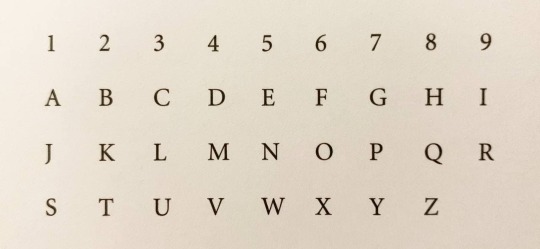
if, as in this case, the number of your chosen name doesn't match you birth number, you could add letters to it to reach the right number, or try with another possible one
Ց. choose your own name and write it in various forms - your witch name should match your birth number cause it's the one thing about you that is unchanging and by doing that you are aligning with the same vibration of the moment you chose to be born
once you have found a proper witch name, practice writing it in various forms of magickal script
գ. here is an example of the name Galadriel written in Saxon runes and its monogram:

from Raymond Buckland's Complete Book of Witchcraft, the Big Blue Book
recommended supplementary reading:
Witchcraft from the Inside by Raymond Buckland
The Meaning of Witchcraft by Gerald B. Gardner
Numerology by Vincent Lopez
#oona's grimoire#witchcraft lesson#witchcraft#raymond buckland#wicca#witches#wicca lesson#witch tools#witch craft#witch clothing#witch name#runes#runic#rune#runemagick#magick#big blue book#blue book#witch#witchblr#witch blog#book of witchcraft
110 notes
·
View notes